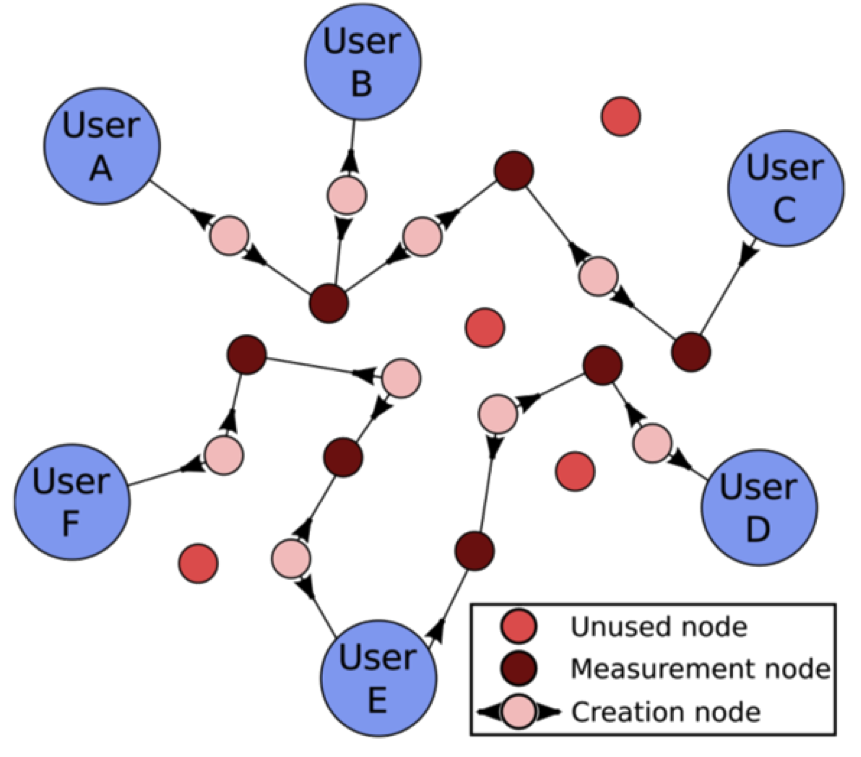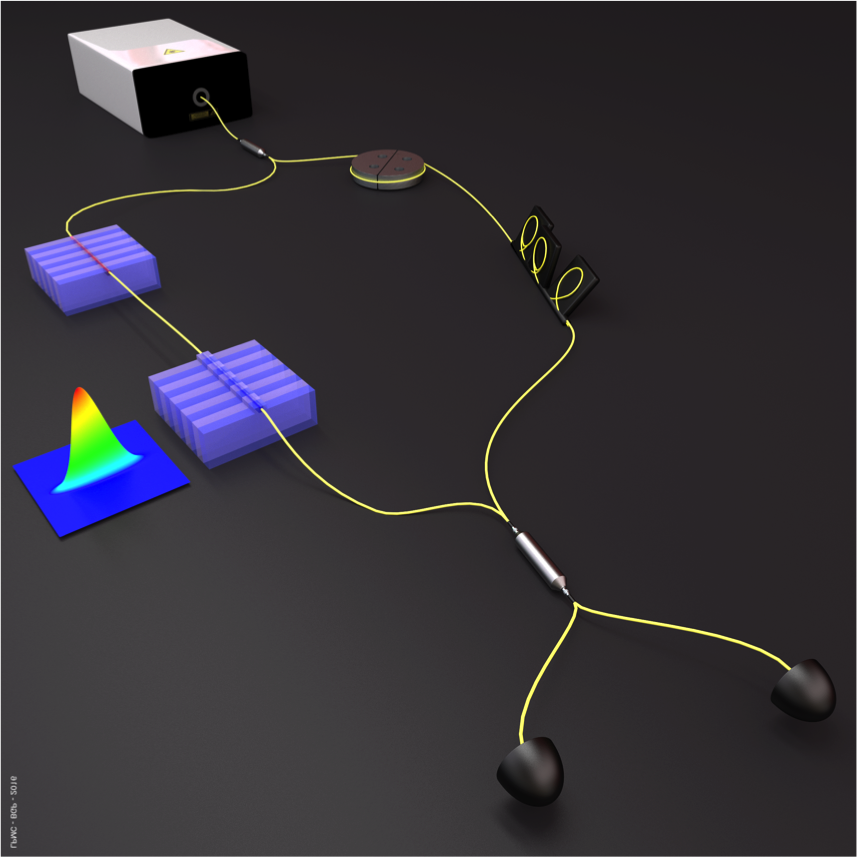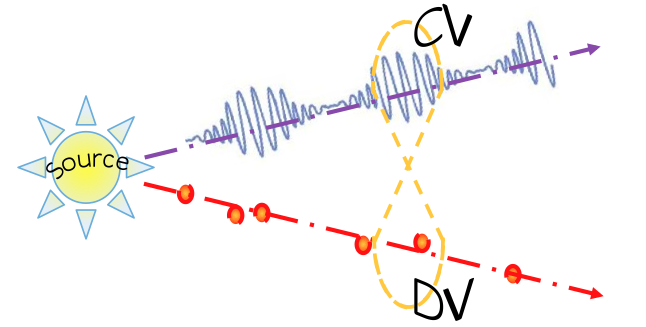All optical synchronization for quantum networks - CONNEQT

Quantum communication requires the transfer of prepared quantum states, or quantum bits of information from one place to another. From a fundamental perspective, this allows, in particular, the distribution of entanglement and the demonstration of quantum correlations over significant distances. At the same time, within the range of applications, quantum cryptography offers a provably secure way to establish confidential keys between distant partners.
In the context of quantum technologies, photons are excellent candidates as information carriers due to the possibility of realizing optical qubits that can be transmitted though optical fibers, manipulated by means of linear optics and interfaced with matter. The presence of telecommunications optical fibers and related technologies provide high-end components making the wavelengths of 1550 nm particularly suitable for qubit distribution over long distances. However, unavoidable propagation losses over fiber channels associated with dark counts in single-photon detectors set a boundary beyond which the signal-to-noise ratio (SNR) is lower than 1, limiting the distance over which quantum cryptography can be investigated.
The project CONNEQT demonstrated a simple, high-speed, and accurate synchronization scheme for long-distance quantum networking. The investigated quantum connection is based on entanglement swapping in a quantum relay configuration, exploiting two independent entangled photon-pair sources that have to be properly synchronized. The requirement of producing high repetition rate synchronized entangled photon sources at arbitrary remote locations and with high accuracy excludes the possibility of using ordinary electronically based synchronization: associated electrical-to-optical conversions would indeed lead to additional time jitters and would prevent from reaching a perfect level of synchronization. The scheme investigated by CONNEQT proposes overcoming this problem by the use of an all-optical distributed-clock synchronization scheme based on the use of standard and reliable non-linear optical and telecommunication components as enabling technologies. In this sense the scheme allows transferring current issues on synchronization to the use of standard and reliable non-linear optical and telecommunication components as enabling technologies. Such a strategy has been successfully tested with two entangled photon pair sources spaced of 100 Km. A patent on the synchronization scheme has been already delivered in Europe and in Japan with the support of CNRS.
Participants at INPHYNI: V. D'Auria (project leader), O. Alibart, L. Labonté, S. Tanzilli, B. Fedrici, L.A. Ngah, F. Kaiser.
The project benefits of technological support from IdQuantique and Prysmian .
It has been funded by the ANR (ANR-emergence CONNEQT, see here), with cofundings by the Région PACA (projet DISTANCE), the CNRS and the Université Nice Sophia Antipolis.
Guided wave CV Quantum Optics

The field of optical quantum communications has been flourishing over the last two decades and has led to spectacular demonstrations, including quantum cryptography and quantum teleportation. In such schemes, two main encoding approaches are followed: on one side, ‘discrete-variable’ encoding based on single-photons and, on the other, ‘continuous-variable’ (CV) encoding relying on continuous degrees of freedom of light modes. A crucial role, common to these two approaches, is played by non-classical correlation (entanglement) between photons generated via non-linear optics systems.
In the last years a new research theme on CV quantum optics at the QPT group has started.
The generation and manipulation of CV nonclassical states of light, such as single- or multi-mode squeezed states, have been the objects of intense research due to their importance in both fundamental and applied physics. Among others, a valuable feature of CV quantum resources is that they can be generated in a deterministic way at the output of nonlinear optical media. In view of its real-world applications, the realization of easy-to-operate experimental systems compatible with existing fiber networks is a now crucial step.
The group “Quantum photonics technologies” (QPT) at the InPhyNi has a well-established and world-recognized experience on single-photon regime quantum information as well as on entanglement production, manipulation, distribution and detection. In particular, INPHYNI also has major competences on the generation of non-classical states based on non-linear optics in Lithium Niobate waveguide.
In collaboration with the INO-Lens quantum optics group, we have demonstrated the first realization of a squeezing experiment fully based on guide-wave off-the-shelf linear and non-linear optical components. Our approach, by first combining these two technologies and CV quantum optics, paves the way towards the realization of accessible and versatile experiments for CV quantum communication. Light is emitted at telecom wavelength as demanded for long distance propagation in optical fibres and where plug-and-play and reliable fibre components are available. The compactness and stability of the experiment, compared to free-space configurations, represent a significant advance towards achieving out-of-the-lab CV endoded quantum communications that are fully compatible with long-distance operations in telecom fibers. The next step is to further push this concept and exploit integrated optics to miniaturize CV quantum optical experiments. In this perspective we are investigating at the InPhyNi, an innovative experiment where, for the very first time, CV non-classical light is generated, transmitted and detected by means of a setup fully integrated on a single home-made and reconfigurable optical chip.
Participants at INPHYNI: V. D'Auria (
project leader), S. Tanzilli, F. Mondain, É. Gouzien, T. Lunghi, F. Doutre, M. De Micheli, D. Aktas, B. Fedrici.
This project is conducted in collaboration with A. Zavatta from the INO - Lens Florence (see
here)
Hybrid Quantum Light - HyLight

The wave-particle duality of light has led to two traditionally-separated encodings of information: a ‘discrete-variable’ (DV) approach, based for instance on single photons, and a ‘continuous-variable’ (CV) one, which relies on continuous degrees of freedom such as amplitude and phase of a light field. Both regimes present specific advantages and drawbacks.
In this context, very recently, hybridization between DV and CV tools and concepts has been foreseen as a key approach to gather the benefits from both regimes and to circumvent their individual limitations. Hy-Light enters into this emerging but potentially powerful endeavor. More specifically, the present research program will exploit as a fundamental resource hybrid entanglement between particle-like and wave-like optical qubits. This complex photonic resource brings together both DV and CV approaches and holds, among other, the promise of transferring information from an encoding to the other. Depending on the specific situation, it is thus possible to take alternatively advantage of CV or DV capabilities.
These promising features has motivated an increasing number of theoretical proposals involving hybrid entanglement as a resource for fundamental quantum optics as well as for QI. Nevertheless, the field is at its very early infancy and, so far, only two experimental realizations of hybrid entangled states have been demonstrated. Hy-Light takes the challenge to push these very first generation experiments towards new testable concepts and innovative protocol implementations to harness this potential approach. It will explore the non-classicality of hybrid states and develop novel adapted witnesses and characterization tools and tackle the implementation of first advanced protocols in both quantum communication and quantum computing, using the potential of this yet unexplored photonic resource.
Participants at INPHYNI: V. D'Auria (project leader), S. Tanzilli, O. Alibart
This project is conducted in collaboration with the group of Julien Laurat at Laboratoire Kastler Brossel (see here) and
with the theoretical group of Thomas Coudreau and Pérola Milmann at Laboratoire Matériaux et Phénomènes Quantiques (see here)
The project benefits from a 42 months ANR funding (ANR appel à projets générique 2017 HY-LIGHT) starting in January 2018.